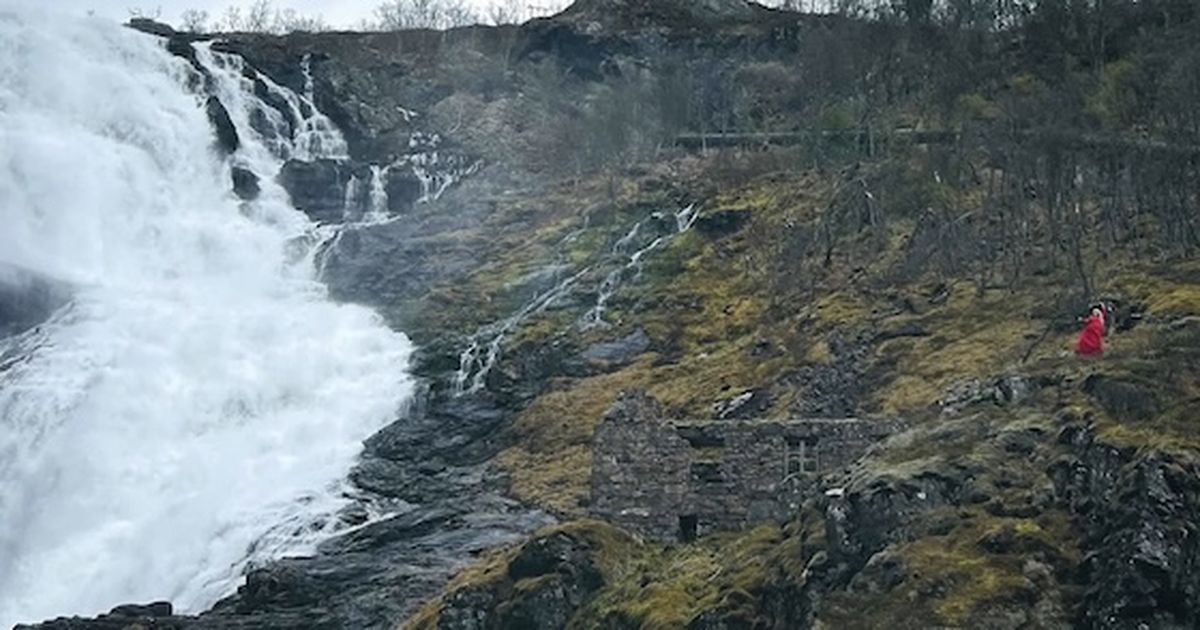(And so I continue writing about the Norway trip that my wife, Mary Pat Treuthart, and I took in May.)
Tuesday, May 13, 9:36 a.m. (Central European Summer Time): We’re sitting in a train car headed for what’s billed as Norway’s “No. 1 tourist attraction.”
Considering what we’ve already seen in Oslo, Bergen and Nordfjordeid, that’s a fairly big promise. But it makes for a great selling point as we joined a long line of other cruise-ship passengers ready to board cars of the Flåm Railway.
Recalling his childhood, when his father worked for the railway, a train engineer named Thor Are Mølster told the website Visit Norway how much he loves the 20-kilometer (nearly 12 and a half mile) trek from Flåm up 867 meters to the station at Myrdal.
“Especially on a clear spring day, when there’s still a lot of snow on the mountaintops, I don’t think there’s any place in the world that is more beautiful,” he said.\
Today is one of those clear days. As we chug up the mountain, I read about what in Norwegian is called the “Flåmsbana.” These days, two different trains head up and down the line from 6 a.m. to 10 p.m. As early as 1908 Norway authorities had recognized the need for a way to connect the country’s remote, roadless interior hamlets with larger communities.
When work on the Flåm section began in 1923, the challenges were daunting. Some 20 tunnels measuring nearly six kilometers had to be constructed.
“It might not be as impressive today,” Are Mølster said, “but they obviously didn’t have modern equipment then, so most of the work had to be done by hand.”
9:40 a.m.: Almost immediately we passed by one of the notable waterfalls, Rjoandefossen, which the guidebook tells me is 300 meters tall with the water dropping some 147 meters. It’s located only five kilometers from Flåm itself, so is a popular hiking attraction. But our train powered on.
10:15 a.m.: Then the train does stop, if only for five minutes. But it’s worth it as we’re offered a sight of one of the country’s most noted waterfalls: Kjosfossen.
And the sight of the falls, which seems more like a long series of rapids rushing more than 200 meters down a steep slope, is indeed impressive.
But that’s hardly what draws most people to it. After all, it’s hardly as imposing a sight as many of the wateralls that seem to jump out from behind every other bend on Iceland’s Ring Road. No, the attraction is the huldra.
According to both Scandinavian and Germanic folklore, huldra – which translates as “hidden” – are forest temptresses that use their sexual powers to attract men who, ultimately, go mad. And sure enough, once we join the passengers at the waterfalls overlook, the music that’s playing – I wrote in my journal “blaring” – soon attracts a mysterious woman in red.
I say “woman” but it would be more accurate to say “women” as just after one red-clad figure disappears behind a rock, another emerges as many as 20 or more yards away. We’re supposed to believe that these forest creatures, not nearly so hidden, are all one and the same – and that they are beckoning us to come and join them.
I’ll admit here that I missed seeing them at first. Even in late spring, the temperature in this part of Norway is chilly. So after a couple of minutes taking photos of yet another waterfall, I decamped back inside the train without having seen any of the huldra creatures.
Mary Pat, her sister Jean and her husband Steve all smiled at me. I did not smile back.
10:42 a.m.: Luckily, though, we were still heading up and soon were at the Myrdal station, which offers little more than a café and the chance to buy souvenirs. It’s also the stopping-off point for hiking and biking trails, and a connection to the Bergen railway that runs between Bergen and Oslo. So we stepped out, looked around, and then reboarded the train.
Unfortunately, we took different seats, and they just happened to be in a car that had been reserved for a tour group. By the time we figured this out and moved, we ended up having to sit separately from one another on the hour-long return trip.
11:17 a.m.: It was on that return leg that I did end up seeing the huldra, whose dances I found interesting but not nearly seductive enough to make me climb up toward them. If I had, I’d likely been disappointed seeing as they were just students from the Norwegian National Academy of Ballet hired to entertain those who take the train.
Anyway, upon returning to Flåm, we lunched at AeGir Brew Pub where, in a faux but enjoyable Viking atmosphere, we enjoyed food served by a tall, bearded guy who could have starred in a movie adaptation of the life of Erik the Red. Then we hit a couple of the town’s busy souvenir shops before heading back to the ship and winning, as a team, our third cruise-line trivia contest in a row.
That evening, before dinner, we sat in the ship’s aft lounge and sipped drinks while listening to a semi-talented guy sing covers of pop songs. That gave me time to look back on the day and think again about train travel, scenic waterfalls and Norwegian folklore.
I wondered whether the huldra would beckon me later than night in my dreams. The thought was far less enticing than you might imagine.
I’ve seen too many movies by the writer-director Ari Aster.
Next up: A van ride and a view to remember.
